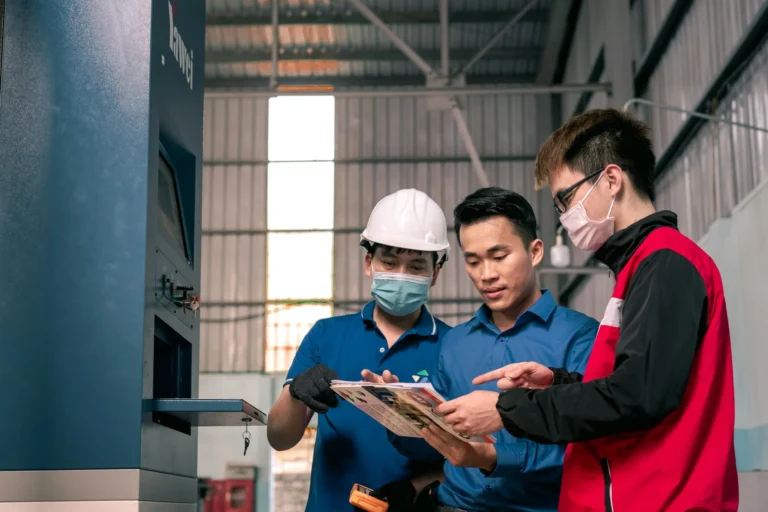Effective communication and collaboration in construction projects form the backbone of its success. With multiple stakeholders involved – including architects, engineers, project managers, contractors, and clients – the flow of information needs to be seamless and efficient. Technology plays a pivotal role in enhancing these crucial aspects, providing tools that foster better communication, increase transparency, and streamline collaborative efforts.
In the construction industry, projects often involve numerous participants, each with their own specific roles and responsibilities. Traditional communication methods can lead to information silos, delays, and misunderstandings. In contrast, digital communication tools can break down these barriers, facilitating real-time information exchange and ensuring that everyone stays on the same page.

Project management software, like Wunderbuild, is a game-changer in this regard. These platforms provide a centralised space where project information is stored and can be accessed by all relevant parties. Everything from project plans and progress updates to resource allocation and task assignments can be managed within these platforms.
Instant messaging and conferencing tools are also becoming increasingly popular in the construction industry. These tools enable real-time communication, allowing team members to discuss issues, share ideas, and make decisions promptly. Video conferencing can also help remote team members feel more connected, bridging the gap created by physical distance.
Document sharing and cloud storage platforms further enhance collaboration. Instead of having to email documents back and forth or store them on individual computers, team members can upload documents to a central location where everyone can access them. This not only makes document sharing easier but also ensures that everyone is working with the most up-to-date information.
Mobile technology is another area where technology is improving communication and collaboration. Many construction professionals now use smartphones and tablets on job sites, giving them access to project information wherever they are. This can be particularly useful for tasks like site inspections and progress reporting, where information needs to be shared quickly with the rest of the team.
Digital design tools, such as Building Information Modelling (BIM), have also revolutionised the way architects, engineers, and contractors collaborate. BIM allows for the creation of detailed 3D models that can be shared and updated in real-time, reducing the risk of misunderstandings and costly rework. It also facilitates better coordination between different trades, helping to identify potential issues before they become problems.
Despite the clear benefits of using technology to improve communication and collaboration, it’s important to remember that successful implementation requires more than just purchasing new software or hardware. It involves a shift in culture, with all team members needing to embrace these new tools and understand how to use them effectively. Training and support are key to ensuring that everyone is comfortable with the technology and knows how to use it to their advantage.
In the realm of construction, virtual reality (VR) and augmented reality (AR) are emerging as powerful tools for enhancing communication and collaboration. VR allows stakeholders to virtually walk through a 3D model of a project before it’s built, providing a unique opportunity to visualise the finished project and discuss any potential issues. Similarly, AR overlays digital information onto the physical world, allowing workers on-site to see where elements of the project will go, improving precision and reducing the likelihood of errors. In Australia, many construction companies are starting to harness the potential of VR and AR, leading to more efficient and effective project delivery.
Wearables and IoT devices are also becoming more prevalent in construction. These technologies can monitor various aspects of the construction site, from worker safety to equipment use. This real-time data can be shared instantly with the relevant parties, allowing for quick decision-making and enhanced collaboration. For example, if a piece of equipment malfunctions, an IoT device can send an alert to the project manager, who can then coordinate with the maintenance team to address the issue promptly.
In addition to the technologies mentioned, advancements in AI and machine learning are set to further revolutionise communication and collaboration in construction. These technologies can analyse large volumes of project data to provide insights and predictive analytics, which can inform decision-making and facilitate more effective collaboration. AI can also automate certain administrative tasks, freeing up time for team members to focus on more complex aspects of the project.
As technology continues to evolve, we will undoubtedly see the emergence of new tools and platforms designed to enhance communication and collaboration in construction. The challenge for the industry will be to stay abreast of these developments and understand how to leverage them effectively.

As we have seen, technology is playing a pivotal role in transforming the way communication and collaboration occur in the construction industry. From project management software and instant messaging tools to digital design technologies, cloud storage, and emerging technologies like VR, AR, AI, and IoT, the landscape of construction communication is changing rapidly. This shift towards a more connected, collaborative construction industry is not just improving project outcomes, but it’s also shaping the future of the sector.
It’s an exciting time for the construction industry. As these technologies become more integrated into our daily practices, we’re building an environment where ideas flow freely, problems find quicker resolutions, and projects come to life more efficiently. This is more than just a technological shift; it’s a step towards a more collaborative, communicative, and efficient future for construction. The industry isn’t just building structures – it’s building connections, and technology is the catalyst making this possible.
While we’ve touched on many individual technologies that are reshaping communication and collaboration in construction, it’s important to also consider how these technologies can be integrated for optimal effect. The real power of these tools lies in their ability to work together, creating a digital ecosystem that supports all aspects of a construction project.
Consider, for example, the interplay between project management software, instant messaging tools, and digital design technologies. A change made in a Building Information Modelling (BIM) system can be instantly reflected in the project management software, alerting relevant team members to the update. At the same time, instant messaging tools can facilitate real-time discussion around this change, allowing for quick decision-making and resolution of any issues. This integrated approach ensures that all team members have access to the most up-to-date information and can collaborate effectively, regardless of their physical location.
Similarly, the combination of wearable technology, IoT devices, and AI could create a highly responsive and efficient construction site. Wearables and IoT devices can monitor various aspects of the site in real-time, providing a constant stream of data that can be analysed by AI systems. These systems could then provide predictive insights or instant alerts in response to this data, facilitating rapid response to any potential issues.
The key to harnessing the full potential of these technologies lies in understanding their individual capabilities and how they can be combined for greatest effect. It requires a forward-thinking approach and a willingness to embrace new ways of working. As the construction industry continues to navigate its digital transformation, those who can successfully integrate these technologies will be well-positioned to lead the way.
With the integration of technology into the construction industry, we’re not just building structures – we’re building a digital ecosystem that enhances communication, fosters collaboration, and drives efficiency. As we embrace this interconnected future, the possibilities for what we can achieve are truly exciting. The future of construction communication and collaboration is here, and it’s digital.
As we embrace these technological advancements, it’s important to choose tools that are designed with the needs of the construction industry in mind. Wunderbuild is one such tool that is making waves in the industry. It’s more than just a project management software; it’s a comprehensive platform that supports real-time communication, effective collaboration, and seamless integration with other digital tools. With Wunderbuild, construction teams can stay connected and coordinated, no matter where they are. It ensures everyone has access to the latest project information, helping to eliminate misunderstandings and reduce rework. Moreover, its user-friendly interface makes it easy for all team members to get on board. If you’re looking to improve communication and collaboration in your construction projects, Wunderbuild could be the solution you’re looking for. Discover more about what Wunderbuild can offer here.




